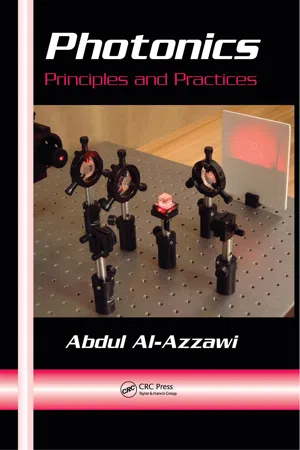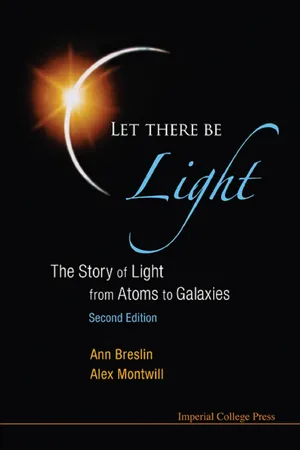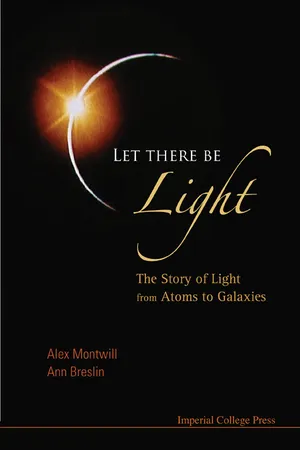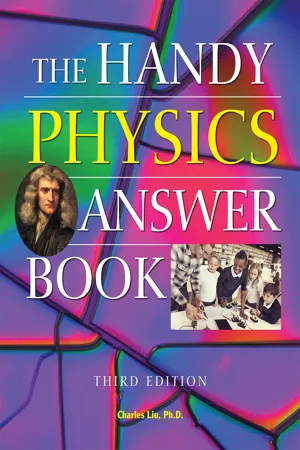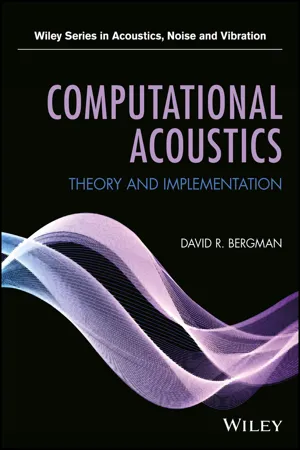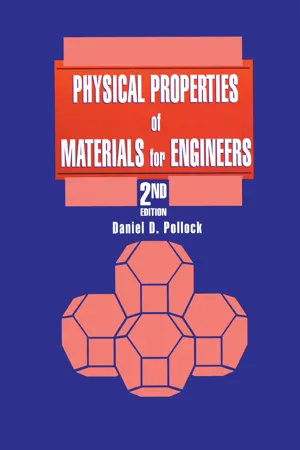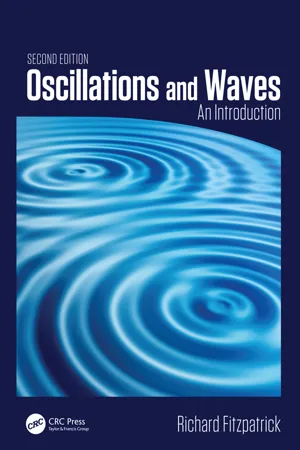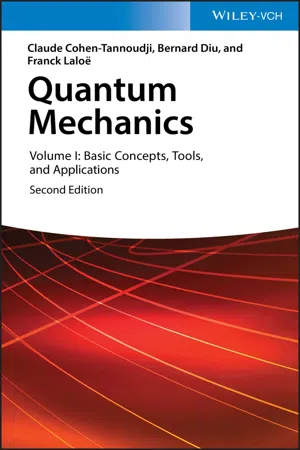Physics
Waves Physics
Waves in physics refer to the transfer of energy through a medium or space. They can be categorized as mechanical waves, which require a medium to propagate, or electromagnetic waves, which can travel through a vacuum. Waves exhibit properties such as amplitude, frequency, wavelength, and speed, and they play a fundamental role in various natural phenomena and technological applications.
Written by Perlego with AI-assistance
Related key terms
Related key terms
1 of 4
Related key terms
1 of 3
11 Key excerpts on "Waves Physics"
- eBook - ePub
Photonics
Principles and Practices
- Abdul Al-Azzawi, Brian J. Thompson(Authors)
- 2017(Publication Date)
- CRC Press(Publisher)
Section IIIWaves and Diffraction
Passage contains an image
17 Waves17.1 INTRODUCTION
Previous chapters explained that light acts as a stream of particles that allow the light to transfer from one point to another. The coming chapters will deal with light as a wave. The purpose of this chapter is to explain the basic principles of light when transmitted, reflected, or refracted through an optical material as a wave.Energy can be transmitted from one place to another by vibrating objects, such as water waves that travel hundreds of kilometres over the ocean. The water particles move up and down as the wave passes. Similarly, when you shake a spiral spring, your energy is transferred from coil to coil down the spring. A wave is a transfer of energy in the form of vibrating particles in a medium. We live in a world surrounded by waves; some are visible and others are not. Water waves and the waves generated by a rope or a spring can be seen. Sound waves and radio waves cannot be seen. Waves also occur in light, sound, heat, microwaves, and in the ultra-microscopic world of atoms. Several types of waves and their applications will be presented in this chapter. Also in this chapter, along with the theoretical presentation, three experimental cases demonstrate the principles of Hook’s law, wave generation, and the simple pendulum.17.2 THE NATURE OF WAVES
17.2.1 ENERGY TRANSFERThere are various ways in which energy can be transferred from one place to another. The flow of heat through a metal from a region of high temperature to one of low temperature represents one method of transferring energy. The flow of electricity through a metal is somewhat analogous to heat flow. The conduction of heat energy and electric energy through metals depends upon the motion of particles that compose the metal.The transfer of energy by the gross movement of materials or objects from one place to another is the basic principle of the nature of waves. Winds, tides, and projectiles in flight are examples for this type. Another method of energy transfer involves wave motion when a stone thrown into a quiet pond produces a familiar wave pattern on the surface of the water. A sound is heard because a wave disturbance travels from the source through the intervening atmosphere. The energy released by a great explosion can shatter windows far from its source. The shock wave of a supersonic airplane can have similar destructive effects. - eBook - ePub
Let There Be Light
The Story of Light from Atoms to Galaxies
- Ann Breslin, Alex Montwill(Authors)
- 2013(Publication Date)
- ICP(Publisher)
A stone dropped into the middle of a pond gives rise to waves spreading out on the surface of the water in ever-increasing circles. The expanding waves show that something definitely propagates, but it is not the water itself; ducks sitting in the path of the wave bob up and down but do not necessarily move in the apparent direction of propagation. Energy contained in the local oscillations of individual water particles is transmitted with no net motion of these particles from the middle of the pond to its edge.Surface waves created by dipping a stick into water. Courtesy of Roger McLassus.Waves transmit energy, momentum and information from one place to another by means of coordinated local oscillations about an equilibrium position.Waves, whether naturally occurring or artificially produced, can be classified according to the type of disturbance which is transmitted, and also by the relationship between the direction in which things change locally and the direction of energy transfer.When molecules are stimulated by an external force which varies periodically (repeats itself at regular intervals), they vibrate and a mechanical wave is set in motion. Individual molecules remain localized, but energy is transferred from molecule to molecule and hence from one place to another. The energy is transmitted through the material by molecular interactions but the precise nature of the interaction depends on the material. On the macroscopic scale, we refer to the level of the molecular response as the elasticity of the material.Mechanical waves are propagated by the interaction of molecules with their neighbours and do not exist in a vacuum.Transverse wavesEnergy may be transmitted by particles oscillating in a direction either perpendicular or parallel to the direction of energy transfer. In the disturbance caused by the stone, the water surface moved up and down, but the wave moved horizontally. This sort of wave is called a transverse wave. - eBook - ePub
Let There Be Light
The Story of Light from Atoms to Galaxies
- Alex Montwill, Ann Breslin(Authors)
- 2008(Publication Date)
- ICP(Publisher)
A stone dropped into the middle of a pond gives rise to waves spreading out on the surface of the water in ever-increasing circles. The expanding waves show that something definitely propagates, but it is not the water itself; ducks sitting in the path of the wave bob up and down but do not necessarily move in the apparent direction of propagation. Energy contained in the local oscillations of individual water particles is transmitted with no net motion of these particles from the middle of the pond to its edge.Waves transmit energy, momentum and information from one place to another by means of coordinated local oscillations about an equilibrium position.Waves, whether naturally occurring or artificially produced, can be classified according to the type of disturbance which is transmitted and also by the relationship between the direction in which things change locally and the direction of energy transfer.When molecules are stimulated by an external force which varies periodically (repeats itself at regular intervals), they vibrate and a mechanical wave is set in motion. Individual molecules remain localised, but energy is transferred from molecule to molecule and hence from one place to another. The energy is transmitted through the material by molecular interactions but the precise nature of the interaction depends on the material. On the macroscopic scale, we refer to the level of the molecular response as the elasticity of the material.Mechanical waves are propagated by the interaction of molecules with their neighbours and do not exist in a vacuum.6.1.2 Transverse wavesEnergy may be transmitted by particles oscillating in a direction either perpendicular or parallel to the direction of energy transfer. In the disturbance caused by the stone, the water surface moved up and down, but the wave moved horizontally. This sort of wave is called a transverse wave.A transverse wave is a wave for which the local disturbance is perpendicular to the direction of propagation of energy.We need some form of bonding to support a transverse wave. When molecules are bonded together, transverse waves can propagate. The bonding must be such that, when a molecule moves up and down, it tends to drag neighbouring molecules with it. Force is required to disturb the molecule and the phenomenon is technically known as resistance to shearing stress. - eBook - ePub
- Charles Liu(Author)
- 2020(Publication Date)
- Visible Ink Press(Publisher)
WAVES
What is a wave?
A wave is a traveling disturbance that moves energy from one location to another without transferring matter. Oscillations in a medium or material create mechanical waves that propagate away from the location of the oscillation. For example, a pebble dropped into a pool of water creates vertical oscillations in the water, while the wave propagates outward horizontally along the surface of the water.What are the two main forms of waves?
Transverse waves and longitudinal waves are the two major forms of waves.In a transverse wave, the wave itself and its energy move away from the source perpendicular to the direction of the oscillations. A transverse wave can be created, for example, by repeatedly shaking a string or rope up and down. The string moves up (the highest point is called the “crest”) and down (the lowest point is called the “trough”) while the wave travels.The oscillations in longitudinal waves move in the same direction that the wave is moving. A longitudinal wave can be created, for example, by repeatedly pushing and pulling on a long, soft spring.Can the two main forms of waves be combined?
Yes, they often do combine. Ripples in a pond, for example, are a combination of transverse and longitudinal waves that can move outward in circles. As in the case of transverse and longitudinal waves alone, energy is transferred, but matter is not moved.What determines the velocity of a wave?
The velocity of a wave depends upon the material or medium in which it is traveling. Typically, the stronger the coupling between the atoms or molecules that make up the medium and the less massive they are, the faster the wave will travel. All waves of the same type (transverse or longitudinal) travel at the same speed through the same medium. For example, a sound wave in air at 0°C will travel at 331 meters per second regardless of the sound’s frequency or amplitude. - eBook - ePub
Computational Acoustics
Theory and Implementation
- David R. Bergman(Author)
- 2018(Publication Date)
- Wiley(Publisher)
Wave phenomenon can be identified in many physical systems, and a large class of phenomenon are now understood to be wave phenomenon. Optics, for example, was studied for many centuries before it was understood that light was an electromagnetic vector wave, and later a photon. It has a set of laws that have been determined by observation and can be used to make predictions regarding the formation of images by mirrors and lenses and the deformation of images by changes in refractive index of materials. It wasn’t until a complete theory of electromagnetism had developed that a derivation of such laws mathematically from first principles was possible. Sound, as experienced by us, is the result of mechanical waves traveling through air from a source to our bodies. Impinging on our bodies, these waves induce mechanical vibrations that in turn stimulate signals in nerves that are sent to the brain for processing. The frequency of a wave is for the most part determined by the source. Different media will produce waves of different wavelength for the same source, but all will register the same frequency. In optics wavelength is associated with color. It is understood that when light is passed through different materials, its wavelength will change, but its frequency will not. Perhaps for historical reasons color is labeled by wavelength, in vacuum, rather than frequency. In music, the pitch of a note is determined by frequency. When a source generates waves of a single frequency, it is referred to as monochromatic, borrowing jargon from optics.A description of waves as an independent entity with certain properties related to a source and the medium of propagation has been presented here. All acoustics is mechanical vibration, so one should expect that a theory of how connected particles respond to each other’s movement will also describe acoustic phenomenon. Motivated by this several descriptions of waves and their underlying medium will be presented. The reader should keep in mind that the intent is not to build a particle model of acoustics. The last thing anyone wants to do is model the movement of every water molecule in the ocean to arrive at a solution for a plane wave. The virtue of studying the wave as an entity is that the tiny details of the particle movement that help produce and sustain the wave become ignorable. Before delving into the mathematical theory of waves, a few topics that have not been covered in the previous description are mentioned. The first is attenuation. Any wave traveling through a material is going to experience some form of damping, much like a simple harmonic oscillator with air friction added. Damping can be included in the description of a wave by letting the wavenumber acquire an imaginary component. Note that (3.6) - eBook - ePub
- Daniel D. Pollock(Author)
- 2020(Publication Date)
- CRC Press(Publisher)
CHAPTER 2Waves and Particles
2.1 INTRODUCTION
Einstein assumed duality between radiation and particles (Section 1.4 ). Experiments involving electrons and diffraction effects are described to illustrate such behaviors. These show the need for the statistical treatment of electrons.Classical physics and Einstein’s findings unmistakably demonstrated that light possessed both wave and particle properties. If light is corpuscular in nature, how can diffraction phenomena be explained? This question could be resolved if it were assumed that the waves and particles were associated in some way. It had already been assumed by Einstein and others that photons, wave quanta, etc., had energies that correspond to their frequencies: E = hv. The nature of this wave-particle relationship and its consequences are considered in this chapter.To understand their nature, the optical properties of electrons (similar to those properties employed in electron microscopes) are used to show some of the reactions of electrons of significance.2.2 ELECTRON OPTICS
The responses of electrons in electric and magnetic fields are evidence for their existence as charged particles. They move in straight lines in electric and magnetic fields, and their direction of motion changes when the strength of the electric fields change, neglecting magnetic fields. Under these conditions, electron beams may be considered to be matter waves that obey the laws of geometric optics. They can be made to act so that they reflect and refract. Consider Figure 2-1 , in which the refraction of electrons is simulated. Electrons from the source enter chamber 1, across which is a uniform potential V1 . They pass through the opening between the evacuated chambers and enter chamber 2. This chamber has another higher uniform potential V2 > V1 , across it. The two different electric fields set up by these potentials impart different velocities to the electrons, vP1and vP2, respectively. The direction of motion of the electrons changes when they enter the second, stronger field. This is the only effect of the potentials that must be considered here. The velocity components of the electrons perpendicular to each of the applied fields, vy - Tamer Bécherrawy(Author)
- 2013(Publication Date)
- Wiley-ISTE(Publisher)
Chapter 6Electromagnetic WavesA remarkable property of Maxwell’s equations (that was not possible to foresee before the formulation of the electromagnetic theory) is that they have solutions representing electromagnetic waves propagating at the speed of light in matter and in vacuum. The existence of these waves was experimentally confirmed, in 1890 by Hertz, who succeeded in producing them and verifying that they have the same propagation, interference, diffraction and polarization properties as light waves. Thus, Maxwell theory has enabled us to understand the nature of light as electromagnetic waves with very short wavelengths. Actually, we can produce and detect electromagnetic waves of frequencies varying between 10−2 Hz and 1032 Hz, that is, of wavelengths varying between 1010 m and 10−24 m. They play a very important part in nearly all branches of physics and have a considerable impact on economic, social, political and intellectual life. In this chapter, we recall the principal results of the electromagnetic theory, namely Maxwell’s equations. We discuss their wave solution and some applications of electromagnetic waves.6.1. Principal results of the electromagnetic theory
The basic concepts of the electromagnetic theory are the electric field E and the magnetic induction field B (also called magnetic field for short) defined by their action on a charge q of velocity v[6.1]In the presence of dielectrics, we also have to introduce the electric displacement (also called electric induction ) D = εo E + P where εo = 8.8541878 x10−12 A2 s4 /kg.m3is the electric permittivity of vacuum and P is the density of polarization (or simply polarization ), i.e. the electric dipole moment of the dielectric per unit volume. In the presence of magnetic materials, we also have to introduce the magnetic field strength (also called magnetic intensity ) H = B/µo - M where µo = µo = 4π x 10−7 kg.m/A2 s2 is the magnetic permeability of vacuum and M is the intensity of magnetization (or simply magnetization- eBook - ePub
- Michael M. Mansfield, Colm O'Sullivan(Authors)
- 2020(Publication Date)
- Wiley(Publisher)
pulse. In both cases a disturbance is transmitted; this is an essential feature of any wave motion.A wave pulse along a string.Figure 13.1For the disturbance to be transmitted in the two examples of wave motion which we have just considered, each particle in the medium (water or string) in which the wave motion is taking place must ‘pass the message on’ to its neighbour. For this to happen there have to be interactions between the particles which make up the medium. The velocity with which waves are propagated depends largely on the strength of these interactions.In an elastic medium, a particle which has been disturbed by a wave pulse returns to its equilibrium position after the wave has passed. There is, therefore, no net motion of particles for a wave. This can be demonstrated in the case of a water wave by placing a cork on a still water surface. As a wave passes the cork, it bobs up and down – oscillates – but it does not travel in the direction of the wave. In the case of the wave pulse which moves along the string, there is no net motion of string particles along the string. Although a wave does not transmit material, it clearly transmits energy. As the disturbance moves through the medium, the energy associated with the oscillation of particles in the medium also moves.Two categories of waves may be distinguished – transverse and longitudinal. In a transverse wave (Figure 13.2 ) the disturbance from equilibrium, y, is perpendicular to the direction in which the wave is propagating, that is, it is perpendicular to the direction of the wave velocity, v. Waves across a water surface or waves along a string are both examples of transverse waves and Figure 13.2 can represent either phenomenon. As indicated in the figure, the disturbance from equilibrium can be positive or negative.Figure 13.2 - eBook - ePub
Oscillations and Waves
An Introduction, Second Edition
- Richard Fitzpatrick(Author)
- 2018(Publication Date)
- CRC Press(Publisher)
CHAPTER 6Traveling Waves
6.1 INTRODUCTIONIn this chapter, we shall generalize the analysis of the previous two chapters in order to deal with longitudinal and transverse waves (in continuous media) that propagate; in other words, waves that carry a net energy flux in a particular direction.6.2 STANDING WAVES IN FINITE CONTINUOUS MEDIUMWe saw earlier, in Sections 4.3 and 5.2 , that a small-amplitude transverse wave on a uniform string, and a small-amplitude longitudinal wave on a thin elastic rod, are both governed by the wave equation, which (in one dimension) takes the general form(6.1)=∂ 2ψ∂t 2υ 2,∂ 2ψ∂x 2where ψ(x, t) represents the wave disturbance, and υ > 0 is a constant, with the dimensions of velocity, that is a property of the particular medium that supports the wave. Up to now, we have only considered media of finite length. That is, media that extend from (say) x = 0 to x = (l > 0). Generally speaking, we have encountered two distinct types of physical constraint that hold at the boundaries of such media. First, if a given boundary is fixed then the wave disturbance is constrained to be zero there. For instance, if the left boundary is fixed then ψ(0, t) = 0. Second, if a given boundary is free then the spatial derivative of the disturbance (which usually corresponds to some sort of force) is constrained to be zero there. For instance, if the right boundary is free then ∂ψ(l, t)/∂x = 0. It follows that a fixed boundary corresponds to a node; that is, a point where the amplitude of the wave disturbance is always zero. On the other hand, a free boundary corresponds to an anti-node; that is, a point where the amplitude of the wave disturbance is always locally maximal. Consequently, the nodes and the anti-nodes of a wave, of definite wavelength, supported in a medium of finite length that has stationary boundaries (which can be either fixed or free) are constrained to be stationary. The only simple solution of the wave equation, (6.1) , that has stationary nodes and anti-nodes is a standing wave - eBook - ePub
- Bryan Milner(Author)
- 2019(Publication Date)
- Routledge(Publisher)
A scale model of the wave energy machine. The energy in the waves has been absorbed by the ‘duck’. The duck bobs up and down and this movement energy is converted into electricity.■ Using the energy from water wavesThe diagrams show how we can use the energy from water waves.6 (a) What useful form of energy do the ‘ducks’ produce from the energy carried by waves?(b) You can tell by looking at the water that the ‘ducks’ have transferred most of the energy from the waves. Explain how you can tell.What you need to remember [Copy and complete using the key words]Looking at water waves: Part 2The number of waves each second is called the ____________, and it is measured in ____________ (Hz, for short). Waves transfer ____________ from one place to another without any substance, such as water, being transferred.Waves and radiation 4 Two types of waveThe diagram shows waves moving along a rope.Each wave is a disturbance that travels along the rope, but the rope itself does not travel along.REMEMBER Light and sound can be reflected and refracted just like water waves. So scientists believe that light and sound are waves too.1 (a) In which direction are the waves travelling along the rope in the diagram?(b) Describe how each bit of the rope moves as the waves pass along it.Because each bit of the rope vibrates at right angles to the direction that the waves are travelling, we say that the waves are transverse waves.(‘Transverse’ means ‘across’.) The diagram shows waves moving along a spring.Each wave is a disturbance that travels along the spring, but the spring itself does not travel along.2 (a) In which direction are the waves travelling along the spring in the diagram?(b) Describe how each bit of the spring moves as the waves pass through it.As the waves travel along the spring, each bit of the spring vibrates. These vibrations are along the same direction - eBook - ePub
Quantum Mechanics, Volume 1
Basic Concepts, Tools, and Applications
- Claude Cohen-Tannoudji, Bernard Diu, Franck Laloë(Authors)
- 2020(Publication Date)
- Wiley-VCH(Publisher)
Moreover, the predictions of the measurement results are now only probabilistic (they yield only the probability of obtaining a given result in the measurement of a dynamical variable). The wave function is a solution of the Schrödinger equation, which enables us to calculate ψ (r, t) from ψ (r, 0). This equation implies a principle of superposition which leads to wave effects. This upheaval in our conception of mechanics was imposed by experiment. The structure and behavior of matter on an atomic level are incomprehensible in the framework of classical mechanics. The theory has thereby lost some of its simplicity, but it has gained a great deal of unity, since matter and radiation are described in terms of the same general scheme (wave-particle duality). We stress the fact that this general scheme, although it runs counter to our ideas and habits drawn from the study of the macroscopic domain, is perfectly consistent. No one has ever succeeded in imagining an experiment that could violate the uncertainty principle (cf. Complement D I of this chapter). In general, no observation has, to date, contradicted the fundamental principles of quantum mechanics. Nevertheless, at present, there is no global theory including quantum phenomena within general relativity (gravity) and, of course, nothing prevents the possibility of a new upheaval. References and suggestions for further reading: Description of physical phenomena which demonstrate the necessity of introducing quantum mechanical concepts: see the subsection “Introductory work – quantum physics” of section 1 of the bibliography; in particular, Wichmann (1.1) and Feynman III (1.2), Chaps
Index pages curate the most relevant extracts from our library of academic textbooks. They’ve been created using an in-house natural language model (NLM), each adding context and meaning to key research topics.
Explore more topic indexes
Explore more topic indexes
1 of 6
Explore more topic indexes
1 of 4
